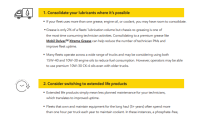Shell Rotella Unveils New Engine Oil Lineup

This story appears in the July 25 & August 1 print edition of Transport Topics.
WASHINGTON — Shell Rotella has unveiled its new lineup of lubricating oils, products designed to maintain the hotter-burning diesel engines coming in January 2017 and beyond.
The two categories of oil — CK-4 and FA-4 — will be available in December and succeed the CJ-4 oils that have been on the market since 2006.
CK-4 will be used more broadly as it is backward compatible with current and older trucks, Rotella executives said at a July 19 press event here. However, FA-4 will be important for trucking, they said, because the low-viscosity formulation is designed specifically for on-highway vehicles.
The oils were developed based on the Proposed Category 11 specification approved by the American Petroleum Institute at the request of diesel engine makers. Engine manufacturers said they need new oils because of new designs necessary to comply with greenhouse-gas and other emissions controls.
“We are sitting at ground zero for PC-11,” Chris Guerrero, a global brand manager for Rotella, said of choosing the nation’s capital for a location. He said the oil rollout will coincide with the start of the second half of federal Phase 1 greenhouse-gas limits on diesel-powered trucks. They take effect Jan. 1.
Guerrero said Rotella engineers updated all six grades, or tiers, of the company’s engine oils, from the basic T1 grade up to the fully synthetic T6. Rotella is the engine oil division of Royal Dutch Shell.
While an engine’s main job is to produce power for propulsion, there also is a premium for them to run hot so they can bake the soot off of diesel particulate filters.
Dan Arcy, a Rotella technical manager, said the company’s engineers had three primary design goals: oxidation stability, aeration control and shear stability. Oil oxidizes under intense heat, he said, and that has to be minimized.
Aeration control means the oil should be purged of as much air as possible, and shear stability means it should last for well more than a typical 50,000-mile drain interval, despite the constant pounding of metal parts.
Arcy said Rotella is not recommending any change in drain intervals from the CJ-4 family of oils and that truck operators should follow original equipment manager recommendations.
Arcy would not reveal specifically how much Shell Rotella spent to develop the new oils, under development since 2011, but said that “this has been our most expensive category ever.”
An oil standard with two components is unusual, the Rotella managers said, and has not been done since 1994. FA-4 for the engines rolling out in January is designed for durability with lower viscosity.
Low-viscosity engine oil improves fuel economy for two reasons, said Jason Brown, a Rotella technology manager. Oil pumps use less energy moving a thinner oil, and pistons waste less energy when moving through a thinner oil.
Brown said using a thinner 10W-30 oil can generate a 1.6% fuel-economy improvement compared with a more typical 15W-40. For the Society of Automotive Engineers oil classification, a 5W oil is a very thin synthetic, a 10W is often a synthetic-mineral oil blend and a 15W is a traditional mineral oil.
Within a given “W” classification, a -30 oil is less viscous than a -40 type.
Richard Tucker, a Rotella general manager, emphasized the importance of high-temperature, high-shear (HTHS) viscosity.
“The real challenge is maintaining the durability of lower viscosity oils,” he said.
The Rotella mangers described the exhaustive battery of tests the oils went through.
To measure oxidation, the products underwent a 360-hour test run on a Mack Trucks MP8 engine, where the oil pan temperature was 266 degrees Fahrenheit.
The company measured fuel economy as a function of speed and torque, viscosity changes at more than 500 degrees Fahrenheit and accumulation of iron in parts per million.
When biodiesel B5 or B10 was used as fuel, additional checks were made for oxidation and trace elements of copper.
There were 18 tests for wear that examined 66 parameters, said Matt Urbanak, a Rotella technology manger.
“We ran hundreds of engine tests and thousands of bench tests before going into the field,” Urbanak said. For field tests, there was 40 million miles of on-road driving and 50,000 hours for vocational vehicles.
When asked how long the new oils would last as a category, company executives were hesitant to offer an estimate because the Phase 2 greenhouse-gas rule is expected soon, but its details are not yet known. The proposed form of the rule came out in June 2015 and mentioned three stages of change for engine emissions: 2021, 2024 and 2027.
The origination of the current CJ-4 oils family was linked to a January 2007 regulatory change that tightened emissions standards for nitrogen oxide compounds and particulate matter, or engine soot.




